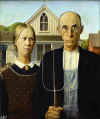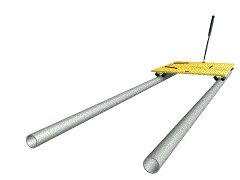
The Film Shot
Distance
is the viewer's perceived distance from the scene depicted.
An Extreme Long Shot/Establishing Shot
A
shot which establishes where the scene is
taking place
Often these are landscape shots
that give a view of a
city, a town, or even a galaxy.
These shots generally taken from a great distance and away from human subjects.
Re-establishing shots: help to distance the audience from a scene that is about
to end, much in the same way chapter conclusions help to break up story flow in
a novel.
Long Shot
One of
the primary functions of the long shot is to establish a context or sense of
place.
Shows the subject from top to bottom; for a person, this would be head to toes, though not necessarily filling the frame. The character becomes more of a focus than an Extreme Long Shot, but the shot tends to still be dominated by the scenery. This shot often sets the scene and our character’s place in it. This can also serve as an Establishing Shot, in lieu of an Extreme Long Shot.

Staging involves filming in very long sequences.
Staging derives its name from its similarity to watching a play being performed on stage.
When you watch a play, there is no camera to cut back and forth between the actors. The audience sees all of the action being performed from a single distance and angle
Is roughly the same distance as that which separates an audience from a theater
stage.
A tableau vivant (often shortened to tableau, plural: tableaux vivants), French for 'living picture', is a static scene containing one or more actors or models. They are stationary and silent, usually in costume, carefully posed, with props and/or scenery, and may be theatrically lit. It thus combines aspects of theatre and the visual arts.A tableau can be simply defined as the arrangement of people and objects within the confines of your cinematic frame.
A well-done tableau shot is the type of artful image that you wouldn’t mind framing and hanging on your living room wall.
https://nofilmschool.com/2015/10/cinematography-wes-andersons-go-to-dp-robert-yeoman
Depth Staging
Depth Staging involves placing the characters in the frame at excessive distances from each other, emphasizing depth.
One character could be all the way down a corridor, while another character can be sitting in a close-up toward the front.
Cinematographer Gregg Toland

Character Shots
Wide and Full Shots
Full Shot
Frames character from head to toes, with the subject roughly filling the frame.
The emphasis tends to be more on action and movement rather than a character’s
emotional state.
The wide shot helps identify both the character and his environment. These shots also allow characters to show body language. Although emotion is important in a close-up and medium shot, body language is important in a full shot as well.
The goal of the wide shot is to establish the single character's position in the frame and his relationship to his surroundings. The director can slowly zoom the camera in to a full, then medium shot to bring the viewer's attention to a character's dialogue or emotion. When that happens, the audience already will understand where the boy is because of the wide establishing shot.
 Edward Hopper.
Nighthawks. 1942
Edward Hopper.
Nighthawks. 1942
Medium Shot
The medium shot creates a balance between character and setting and usually emphasizes a character's upper-body, arms, and head.
The medium shot is a general, all-purpose shot.
Medium shots are used for dialogue sequences, and they allow the viewer to pick up on the character's movements and gestures.
Body language is important to conveying emotion, and the medium shot remains close enough to capture that emotion.
 Grant Wood. American
Gothic. 1930
Grant Wood. American
Gothic. 1930
Cowboy Shot
(aka American Shot) A variation of a Medium Shot, this gets its name from
Western films from the 1930s and 1940s, which would frame the subject from
mid-thighs up to fit the character’s gun holsters into the shot.
A
specific form of medium shot is the two-shot. The two-shot frames two
characters that are interacting so that their reactions to one another can be
viewed simultaneously.
Medium Close-Up
Falls between a Medium Shot and a Close-Up, generally framing the subject from
chest or shoulder up.
Close-up
The
close-up
emphasizes character over setting.
Close-up shots are dramatic and intimate.
Little
of the setting is visible in a close-up
shot.
A
character's affect displays are more in evidence in the close-up.
Choker
A variant of a Close-Up, this shot frames the subject’s face from above the
eyebrows to below the mouth
Emphasizes a small area or detail of the subject, such as the eye(s) or mouth.
An Extreme Close Up of just the eyes is sometimes called an Italian Shot,
getting its name from Sergio Leone’s Italian-Western films that popularized it.
 Alan Moore & Dave Gibbons Watchmen 5,
1986 (Detail)
Alan Moore & Dave Gibbons Watchmen 5,
1986 (Detail)
Shots indicating camera angle/placement
In addition to subject size within a frame, shot types can also indicate where a
camera is placed in relation to the subject. Here are some commonly used terms:
Eye Level
Shot taken with the camera approximately at human eye level, resulting in a
neutral effect on the audience.
High Angle
Subject is photographed from above eye level. This can have the effect of
making the subject seem vulnerable, weak, or frightened.
Low Angle
Subject is photographed from below eye level. This can have the effect of
making the subject look powerful, heroic, or dangerous.
Dutch Angle/Tilt
Shot in which the camera is set at an angle on its roll axis so that the
horizon line is not level. It is often used to show a disoriented or uneasy
psychological state.
Bird’s-Eye View
(aka Top Shot) A high-angle shot that’s taken from directly overhead and from a
distance. The shot gives the audience a wider view and is useful for showing
direction and that the subject is moving, to highlight special relations, or
reveal to the audience elements outside the boundaries of the character’s
awareness. The shot is often taken from on a crane or helicopter.

Camera
Movement Names:
Pan
Pan is the horizontal axis of camera movement. When a camera pans, it turns left to right.
Panning is commonly used to look across a very wide scene (panorama) that doesn't fit within the camera frame (landscape).
This is also known as re-framing the shot.
Tilt
Tilt is the vertical axis of camera movement. When the camera tilts, it pivots up and down. Tilting is commonly used to look over tall objects such as an office building.
To conceptualize a tilt, look forward and move your head to look up and down.
Like the Pan, this technique is used to follow a character in motion.
Dolly
To move the camera horizontally through space.

The Steadycam is an alternative device
Mechanical
Mechanical techniques include the use of devices that allow filmmakers to create unique and interesting camera movements. These are easier to conceptualize when we can move as the camera does....which is possible if a device has a platform that we can sit on.
Cranes and Jibs have a mechanical arm on which the camera is mounted. This arm hinges on a pivot that frees the camera to move through space, allowing sweeping and dramatic camera movements.
Pull Focus
Pulling Focus is considered a natural technique. Like our eyes, which pull focus whenever we look at objects that are at different distances in our field of vision.
We can either focus on something close up or on something far away. Since we can't focus on both simultaneously, our eyes must Pull Focus to compensate.
When filming, Pulling Focus is often needed, because like our eyes, most camera lenses don't keep the entire scene in focus. As the camera moves around, a crew member (focus puller) will adjust the focus to match whatever the camera is looking at.
Try it...
Zoom
The focal length of a camera lens determines the distance that the camera can "see". A Zoom lens allows the focal length to be changed gradually. With a Zoom, the frame may transition from a wide shot to a close-up without moving the camera.
The Zoom is considered an unnatural technique...our eyes cannot incrementally change their focal length. For this reason, Zooms are often used only as an effect.
A very slow Zoom can be an alternative to a dolly movement in locations where there is no room to rig a dolly and track. A very fast Zoom (whip zoom) can be used to draw attention to an object in a scene.
Shot
Transitions:
A transition is any method for switching from one image to another.
A cut is an instantaneous change from one shot or scene to the next. This is the most common type of transition.
an abrupt or sudden change or jump in camera angle, location, placement, or time, from one shot to another;
Jump Cut
an abrupt, disorienting transitional device in the middle of a continuous shot in which the action is noticeably advanced in time and/or cut between two similar scenes, either done accidentally (a technical flaw or the result of bad editing) or purposefully (to create discontinuity for artistic effect).
Match Cut
A match cut is used to make a transition as smooth as possible.
In most films, directors and editors do their best to hide cuts from us. They cut when an action occurs or cut when a character's eyes move.
The most common way to do this is to cut on the action. When an action is started on one frame, the camera cuts, and then the action is finished on the second frame. Because the audience is paying more attention to the action then they are to the cutting of the film, this cut is almost transparent.
Another way to do this is to cut on a look. When an actor shifts his eyes to look at something, the camera cuts to a new image.
A variation on the match cut is a cut in which two shots are joined or linked by visual, aural, or metaphorical parallelism or similarities.
Example: North by Northwest (1959), Cary Grant pulls Eva Marie Saint up the cliff of Mt. Rushmore; then match cut to Grant pulling her up to a bunk in a train;
Cross-cutting
the editing technique of alternating, interweaving, or interspersing one narrative action (scene, sequence, or event) with another - usually in different locations or places, thus combining the two; this editing method suggests parallel action (that takes place simultaneously); often used to dramatically build tension and suspense in chase scenes, or to compare two different scenes; also known as inter-cutting or parallel editing.
Example: in The Godfather (1972), where the baptism of Michael Corleone's godson is cross cut with the violent elimination of Corleone's multiple underworld rivals.
Fade
A fade is the process of gradually coming from or going to black. For example,
at the beginning of a program the screen will usually be black. The black slowly
gives way
Dissolve
A dissolve is the overlapping of shots,
one shot gradually leaves the screen as the next shot gradually appears. For a
time two different shots occupy the screen.
This
length of time can vary but if it remains static it is a superimposition. A
dissolve is usually used to signify a change of time or location, or to add
artistic flavor such as in a musical or dance production.
Wipe

Some References
Types of Shots By Dan Ablan
"The Five C's of Cinematography" by Joseph V. Mascelli
Setting up Your Shots by Jeremy Vineyard